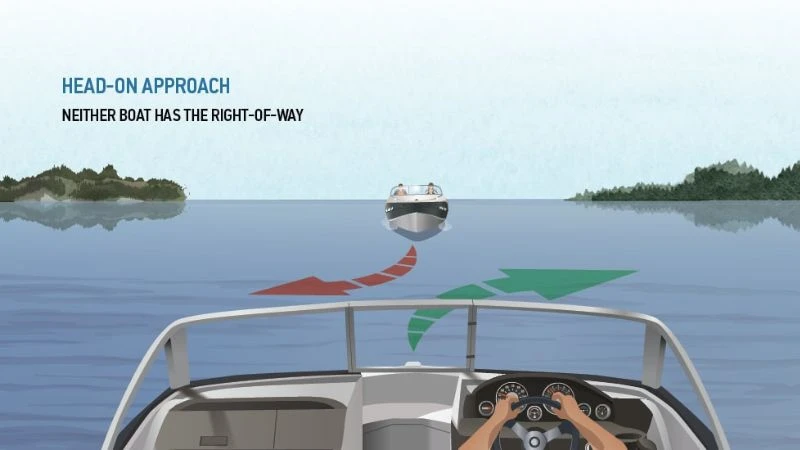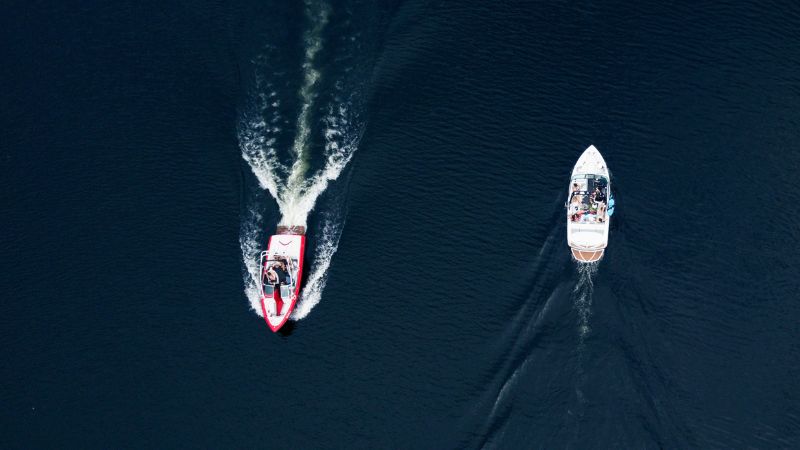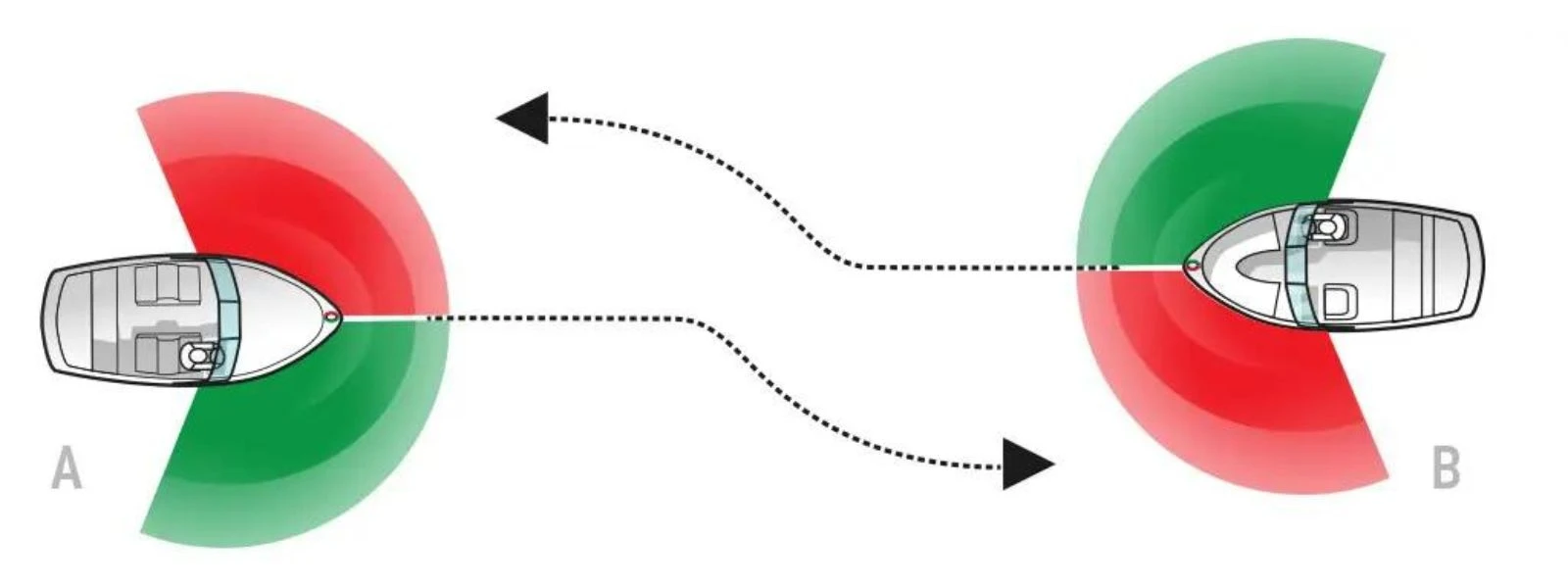What should the operators of two powered vessels do that approach each other in a head on situation? Check out our boating test prep guide!
If you’re preparing for your boat licensing test, one important thing that you will have to know regarding boat safety is understanding what the operators of two powered vessels do that approach each other in a head on situation .
One question commonly seen on boating tests goes over “What should the operators of two powered vessels do that approach each other in a head on situation”. There are rules that every operator must follow and the action a vessel operator should take when encountering another vessel depends on the answers to two questions.
Table of Contents
- What should the operators of two powered vessels do that approach each other in a head on situation?
- Two boats are operating in the same general area. Who is responsible for avoiding a collision?
- A motorboat and a PWC are meeting head-on – Which one is the stand-on vessel?
- One boat is overtaking another. Which boat must give way?
- Who is responsible for avoiding a collision between two boats?
- Two boats are operating near each other. Which is the boat that must maintain its course and speed?
- Two boats are operating in the same general area. Who is responsible for avoiding a collision?
- What should the operators of two powered vessels do that approach each other in a head on situation?
- What should the operator of a stand-on vessel do when encountering a give-way vessel?
- What should the operator of a give-way vessel do to avoid colliding with a stand-on vessel?
- What should the operators of a PWC and a motorboat do when approaching head-on?
- A motorboat is crossing paths with a pwc, what action should be taken?
- A pwc is overtaking another vessel which vessel must give way?
- Tips for preparing for your boating test:
- Check out our other study guides for boating test questions
- Getting Certified: Passing your boat exam
What should the operators of two powered vessels do that approach each other in a head on situation?
When two powered vessels approach each other in a head-on situation, both operators should:
- Alter their course to starboard (right)
- Pass each other port (left) side to port (left) side.
This maneuver reduces the risk of collision by creating a predictable and safe passing arrangement. Additionally, both operators should maintain a safe speed and keep a vigilant lookout for other vessels to ensure a smooth and uneventful passage.

Image courtesy of BOATsmart
Two boats are operating in the same general area. Who is responsible for avoiding a collision?
There are rules that every operator must follow when encountering other vessels. Two terms help explain these rules.
- Give-way vessel: The vessel that is required to take early and substantial action to keep away from other vessels by stopping, slowing down, or changing course. Giving-way should avoid crossing in front of other vessels or changing course and speed in a way that’s large enough to be apparent to the other vessel. It’s important to avoid a series of small changes in course or speed.
- Stand-on vessel: The vessel that must maintain its course and speed unless it becomes apparent that the give-way vessel is not taking appropriate action. If action is necessary, the stand-on vessel should avoid turning toward the give-way vessel or crossing in front of it.
When two boats are operating in the same general area, both operators are responsible for avoiding a collision. The right-of way is determined by answering two questions:
- How are the two vessels propelled?
-
- Two power-driven vessels
- Two sailing vessels
- A power-driven vessel and a sailing vessel
-
- How are the two vessels approaching one another?
-
- Meeting head-on: A vessel operator sees another vessel ahead or nearly ahead
- Paths that cross: Two vessels are on crossing paths so as to involve risk of collision
- Overtaking: A vessel is coming upon another vessel from behind or nearly behind the other vessel
Ultimately, it’s a shared responsibility to maintain a proper lookout, follow navigational rules, and take evasive action if necessary to prevent a collision. Each operator should stay alert, communicate clearly if needed, and maneuver their vessel safely to avoid any potential hazards or collisions.
A motorboat and a PWC are meeting head-on – Which one is the stand-on vessel?
In a head-on situation between a motorboat and a personal watercraft (PWC), the stand-on vessel would typically be the motorboat, assuming both vessels are under power. The motorboat should maintain its course and speed unless it becomes apparent that the PWC is not taking appropriate action.
One boat is overtaking another. Which boat must give way?
When one boat is overtaking another, the boat being overtaken is generally considered the stand-on vessel, while the overtaking boat is the give-way vessel. The overtaking boat must maneuver in a way that ensures a safe and clear passage, keeping well clear of the boat being overtaken. It’s crucial for the overtaking boat to maintain a safe distance and avoid any actions that could potentially cause a collision or endanger the vessel being overtaken.
Who is responsible for avoiding a collision between two boats?
Both boat operators are responsible for avoiding a collision between two boats. It’s essential for both operators to maintain a proper lookout, follow navigational rules, and take necessary actions to prevent a collision. This includes maintaining safe speeds, being aware of the surrounding environment, communicating intentions clearly, and giving way when required by maritime rules and regulations. Ultimately, collision avoidance is a shared responsibility that requires vigilance and cooperation from all parties involved.

Two boats are operating near each other. Which is the boat that must maintain its course and speed?
In maritime situations where two boats are operating near each other, the vessel that must maintain its course and speed is typically referred to as the “stand-on” vessel. This means that unless it becomes apparent that the other vessel is not taking appropriate action to avoid a collision, the stand-on vessel should continue on its current course and speed. However, it’s crucial for the stand-on vessel to remain vigilant and be prepared to take evasive action if necessary to prevent a collision.
Two boats are operating in the same general area. Who is responsible for avoiding a collision?
When two boats are operating in the same general area, both operators are responsible for avoiding a collision. This shared responsibility ensures that both vessels take necessary actions to prevent an accident, adhering to the navigation rules and maintaining a proper lookout to ensure safe and prudent navigation.
What should the operators of two powered vessels do that approach each other in a head on situation?
When two powered vessels approach each other in a head-on situation, both operators should take early and substantial action to avoid a collision. They should both steer to starboard (right) to pass each other on the port (left) side. This is a standard practice under navigation rules to ensure safety and predictability on the water.
What should the operator of a stand-on vessel do when encountering a give-way vessel?
When encountering a give-way vessel, the operator of a stand-on vessel should maintain their course and speed, keeping a lookout for any changes in the give-way vessel’s actions. However, the stand-on vessel must be prepared to take evasive action if it becomes clear that the give-way vessel is not taking appropriate action to avoid a collision. The primary responsibility remains with the give-way vessel to navigate safely around the stand-on vessel.
What should the operator of a give-way vessel do to avoid colliding with a stand-on vessel?
The operator of a give-way vessel should take early and substantial action to avoid colliding with a stand-on vessel. This includes:
- Altering Course and Speed: Make a significant change in course and/or speed to clearly indicate to the stand-on vessel that you are taking action to avoid a collision.
- Communicate Intentions: Use sound signals, such as one short blast to indicate a turn to starboard (right) or two short blasts for a turn to port (left), if necessary, to communicate your intentions.
- Maintain a Safe Distance: Ensure that the maneuver leaves plenty of space between the two vessels, considering their speed, the sea state, and any navigational hazards.
- Monitor the Situation: Keep a constant lookout on the stand-on vessel to ensure that your actions are effective and that the stand-on vessel maintains its course and speed.
By following these steps, the operator of the give-way vessel can safely navigate around the stand-on vessel, reducing the risk of a collision.
What should the operators of a PWC and a motorboat do when approaching head-on?
When the operators of a PWC (Personal Watercraft) and a motorboat are approaching each other head-on, both should take the following actions to avoid a collision:
- Alter Course to Starboard: Both operators should alter their course to starboard (right) so that they pass port side to port side (left side to left side). This is the standard practice for head-on situations.
- Communicate Intentions: If necessary, use sound signals to communicate intentions. One short blast indicates a turn to starboard.
- Maintain a Safe Distance: Ensure that there is a safe distance between the two vessels as they pass each other.
- Keep a Lookout: Both operators should maintain a proper lookout by sight and hearing to avoid any obstacles or sudden changes in the other vessel’s course.
By following these actions, the risk of collision is minimized, and both vessels can navigate safely past each other.
A motorboat is crossing paths with a pwc, what action should be taken?
When a motorboat is crossing paths with a personal watercraft (PWC), the motorboat is usually the “give-way” vessel, and the PWC is the “stand-on” vessel. As the give-way vessel, the motorboat should take early and substantial action to keep well away from the PWC by either slowing down, stopping, or altering its course. The PWC, as the stand-on vessel, should maintain its course and speed, unless it becomes clear that the motorboat is not taking appropriate action to avoid a collision. It’s essential for both operators to remain vigilant, communicate clearly, and take necessary maneuvers to ensure safety and prevent accidents.
A pwc is overtaking another vessel which vessel must give way?
When a personal watercraft (PWC) is overtaking another vessel, it is generally considered the give-way vessel. As such, it must maneuver to pass the other vessel safely, taking into account factors such as speed, distance, and the potential for collision. The vessel being overtaken is typically the stand-on vessel and should maintain its course and speed, allowing the PWC to pass safely. However, both operators should exercise caution, maintain awareness of their surroundings, and communicate effectively to avoid any potential collisions or accidents.
Tips for preparing for your boating test:
Preparing for your boating test? Studying for a boat test in Florida? Here are some helpful tips to get you ready:
- Study the Boating Regulations: Familiarize yourself with the rules and regulations specific to boating in your area. Understand navigation rules, safety requirements, and any local laws governing watercraft operation.
- Take a Boating Safety Course: Consider enrolling in a boating safety course to enhance your knowledge and skills. These courses cover essential topics such as navigation, emergency procedures, and legal requirements.
- Practice Safe Boating Techniques: Learn and practice essential boating maneuvers, including docking, anchoring, and navigating in different weather conditions. Familiarize yourself with basic safety equipment and how to use it effectively.
- Know Your Boat: If you own or plan to operate a specific type of boat, take the time to become familiar with its features, controls, and handling characteristics. Understanding your boat’s capabilities and limitations is essential for safe operation.
- Stay Updated: Keep abreast of any updates or changes to boating regulations and safety guidelines. Stay informed about local weather forecasts and waterway conditions before heading out on the water.
Remember, proper preparation is key to safe and enjoyable boating experiences. Whether you’re in Florida or anywhere else in the country, our excellent guides can help you get ready for your boating test and navigate the waters with confidence.
Check out our other study guides for boating test questions
- How to dock a boat
- How to choose a marine gps app
- What Piece Of Equipment On A Boat Is Most Important In Preventing Propeller Strike Injuries?
Getting Certified: Passing your boat exam
Start your safe boating journey at boat-ed.com. Their accredited courses, recognized by NASBLA, the National Association of State Boating Law Administrators, make learning boater safety, etiquette, and water rules easy and accessible. With interactive courses available on all devices, prioritize safety as you prepare for your exam.
You can get a preview of what this, and other questions may look like on a boating test by visiting our friends at Boat-Ed. Check out their study guide.









